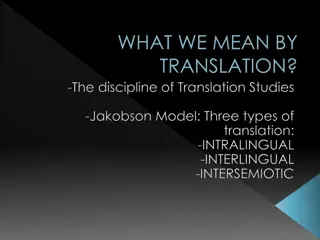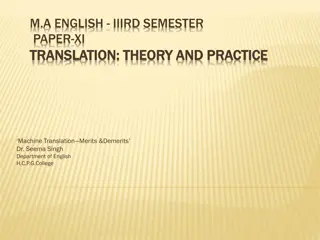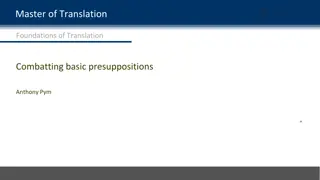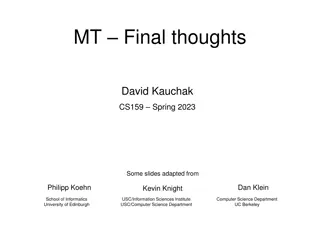Understanding Address Translation in Computer Systems
Explore the concept of address translation in computer systems, covering topics such as converting virtual addresses to physical addresses, different translation methods, goals of address translation, bonus features, and a preview of MIPS address translation. Learn about the benefits and limitations of virtually addressed base and bounds, along with the crucial aspects saved/restored during a process context switch.
Download Presentation

Please find below an Image/Link to download the presentation.
The content on the website is provided AS IS for your information and personal use only. It may not be sold, licensed, or shared on other websites without obtaining consent from the author. Download presentation by click this link. If you encounter any issues during the download, it is possible that the publisher has removed the file from their server.
E N D
Presentation Transcript
Main Points Address Translation Concept How do we convert a virtual address to a physical address? Flexible Address Translation Base and bound Segmentation Paging Multilevel translation Efficient Address Translation Translation Lookaside Buffers Virtually and physically addressed caches
Address Translation Goals Memory protection Memory sharing Shared libraries, interprocess communication Sparse addresses Multiple regions of dynamic allocation (heaps/stacks) Efficiency Memory placement Runtime lookup Compact translation tables Portability
Bonus Feature What can you do if you can (selectively) gain control whenever a program reads or writes a particular virtual memory location? Examples: Copy on write Zero on reference Fill on demand Demand paging Memory mapped files
A Preview: MIPS Address Translation Software-Loaded Translation lookaside buffer (TLB) Cache of virtual page -> physical page translations If TLB hit, physical address If TLB miss, trap to kernel Kernel fills TLB with translation and resumes execution Kernel can implement any page translation Page tables Multi-level page tables Inverted page tables
Question With virtually addressed base and bounds, what is saved/restored on a process context switch?
Virtually Addressed Base and Bounds Pros? Simple Fast (2 registers, adder, comparator) Safe Can relocate in physical memory without changing process Cons? Can t keep program from accidentally overwriting its own code Can t share code/data with other processes Can t grow stack/heap as needed
Segmentation Segment is a contiguous region of virtual memory Each process has a segment table (in hardware) Entry in table = segment Segment can be located anywhere in physical memory Each segment has: start, length, access permission Processes can share segments Same start, length, same/different access permissions
Segment start length code 0x4000 0x700 2 bit segment # 12 bit offset data 0 0x500 heap - - stack 0x2000 0x1000 Physical Memory Virtual Memory main: 240 store #1108, r2 x: 108 a b c \0 244 store pc+8, r31 248 jump 360 main: 4240 store #1108, r2 24c 4244 store pc+8, r31 4248 jump 360 strlen: 360 loadbyte (r2), r3 424c 420 jump (r31) strlen: 4360 loadbyte (r2),r3 x: 1108 a b c \0 4420 jump (r31)
Question With segmentation, what is saved/restored on a process context switch?
UNIX fork and Copy on Write UNIX fork Makes a complete copy of a process Segments allow a more efficient implementation Copy segment table into child Mark parent and child segments read-only Start child process; return to parent If child or parent writes to a segment (ex: stack, heap) trap into kernel make a copy of the segment and resume
Zero-on-Reference How much physical memory is needed for the stack or heap? Only what is currently in use When program uses memory beyond end of stack Segmentation fault into OS kernel Kernel allocates some memory How much? Zeros the memory avoid accidentally leaking information! Modify segment table Resume process
Segmentation Pros? Can share code/data segments between processes Can protect code segment from being overwritten Can transparently grow stack/heap as needed Can detect if need to copy-on-write Cons? Complex memory management Need to find chunk of a particular size May need to rearrange memory from time to time to make room for new segment or growing segment External fragmentation: wasted space between chunks
Paged Translation Manage memory in fixed size units, or pages Finding a free page is easy Bitmap allocation: 0011111100000001100 Each bit represents one physical page frame Each process has its own page table Stored in physical memory Hardware registers pointer to page table start page table length
Process View Physical Memory A B C D I J K L Page Table E F G H 4 3 1 E F G H I J K L A B C D
Paging Questions With paging, what is saved/restored on a process context switch? Pointer to page table, size of page table Page table itself is in main memory What if page size is very small? What if page size is very large? Internal fragmentation: if we don t need all of the space inside a fixed size chunk
Paging and Copy on Write Can we share memory between processes? Set entries in both page tables to point to same page frames Need core map of page frames to track which processes are pointing to which page frames (e.g., reference count) UNIX fork with copy on write Copy page table of parent into child process Mark all pages (in new and old page tables) as read-only Trap into kernel on write (in child or parent) Copy page Mark both as writeable Resume execution
Fill On Demand Can I start running a program before its code is in physical memory? Set all page table entries to invalid When a page is referenced for first time, kernel trap Kernel brings page in from disk Resume execution Remaining pages can be transferred in the background while program is running
Sparse Address Spaces Might want many separate dynamic segments Per-processor heaps Per-thread stacks Memory-mapped files Dynamically linked libraries What if virtual address space is large? 32-bits, 4KB pages => 500K page table entries 64-bits => 4 quadrillion page table entries
Multi-level Translation Tree of translation tables Paged segmentation Multi-level page tables Multi-level paged segmentation Fixed-size page as lowest level unit of allocation Efficient memory allocation (compared to segments) Efficient for sparse addresses (compared to paging) Efficient disk transfers (fixed size units) Easier to build translation lookaside buffers Efficient reverse lookup (from physical -> virtual) Variable granularity for protection/sharing
Paged Segmentation Process memory is segmented Segment table entry: Pointer to page table Page table length (# of pages in segment) Access permissions Page table entry: Page frame Access permissions Share/protection at either page or segment-level
Question With paged segmentation, what must be saved/restored across a process context switch?
Question Write pseudo-code for translating a virtual address to a physical address for a system using 3-level paging.
x86 Multilevel Paged Segmentation Global Descriptor Table (segment table) Pointer to page table for each segment Segment length Segment access permissions Context switch: change global descriptor table register (GDTR, pointer to global descriptor table) Multilevel page table 4KB pages; each level of page table fits in one page 32-bit: two level page table (per segment) 64-bit: four level page table (per segment) Omit sub-tree if no valid addresses
Multilevel Translation Pros: Allocate/fill only page table entries that are in use Simple memory allocation Share at segment or page level Cons: Space overhead: one pointer per virtual page Two (or more) lookups per memory reference
Portability Many operating systems keep their own memory translation data structures List of memory objects (segments) Virtual page -> physical page frame Physical page frame -> set of virtual pages One approach: Inverted page table Hash from virtual page -> physical page Space proportional to # of physical pages
Efficient Address Translation Translation lookaside buffer (TLB) Cache of recent virtual page -> physical page translations If cache hit, use translation If cache miss, walk multi-level page table Cost of translation = Cost of TLB lookup + Prob(TLB miss) * cost of page table lookup
MIPS Software Loaded TLB Software defined translation tables If translation is in TLB, ok If translation is not in TLB, trap to kernel Kernel computes translation and loads TLB Kernel can use whatever data structures it wants Pros/cons?
Question What is the cost of a TLB miss on a modern processor? Cost of multi-level page table walk MIPS: plus cost of trap handler entry/exit
Hardware Design Principle The bigger the memory, the slower the memory
Memory Hierarchy i7 has 8MB as shared 3rd level cache; 2nd level cache is per-core
Question What is the cost of a first level TLB miss? Second level TLB lookup What is the cost of a second level TLB miss? x86: 2-4 level page table walk How expensive is a 4-level page table walk on a modern processor?
Virtually Addressed vs. Physically Addressed Caches Too slow to first access TLB to find physical address, then look up address in the cache Instead, first level cache is virtually addressed In parallel, access TLB to generate physical address in case of a cache miss
When Do TLBs Work/Not Work? Video Frame Buffer: 32 bits x 1K x 1K = 4MB
Superpages On many systems, TLB entry can be A page A superpage: a set of contiguous pages x86: superpage is set of pages in one page table x86 TLB entries 4KB 2MB 1GB























